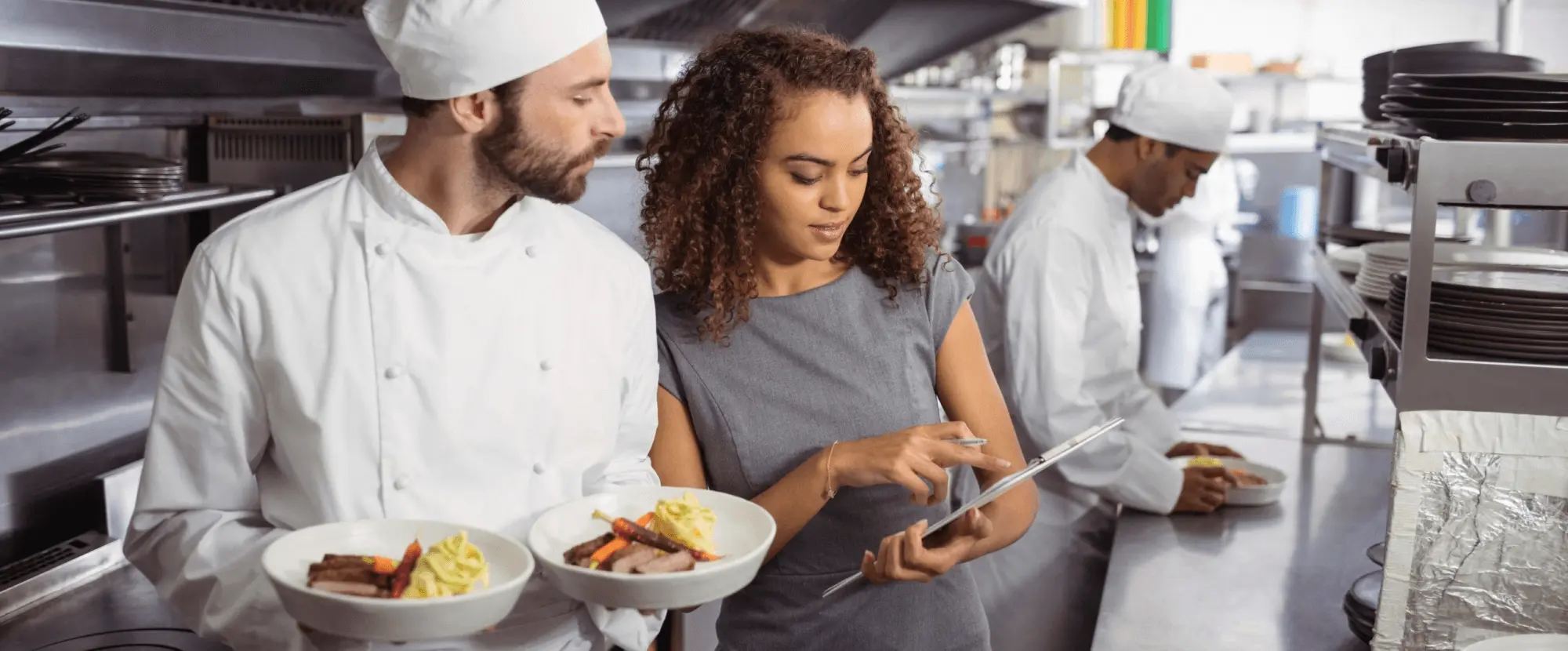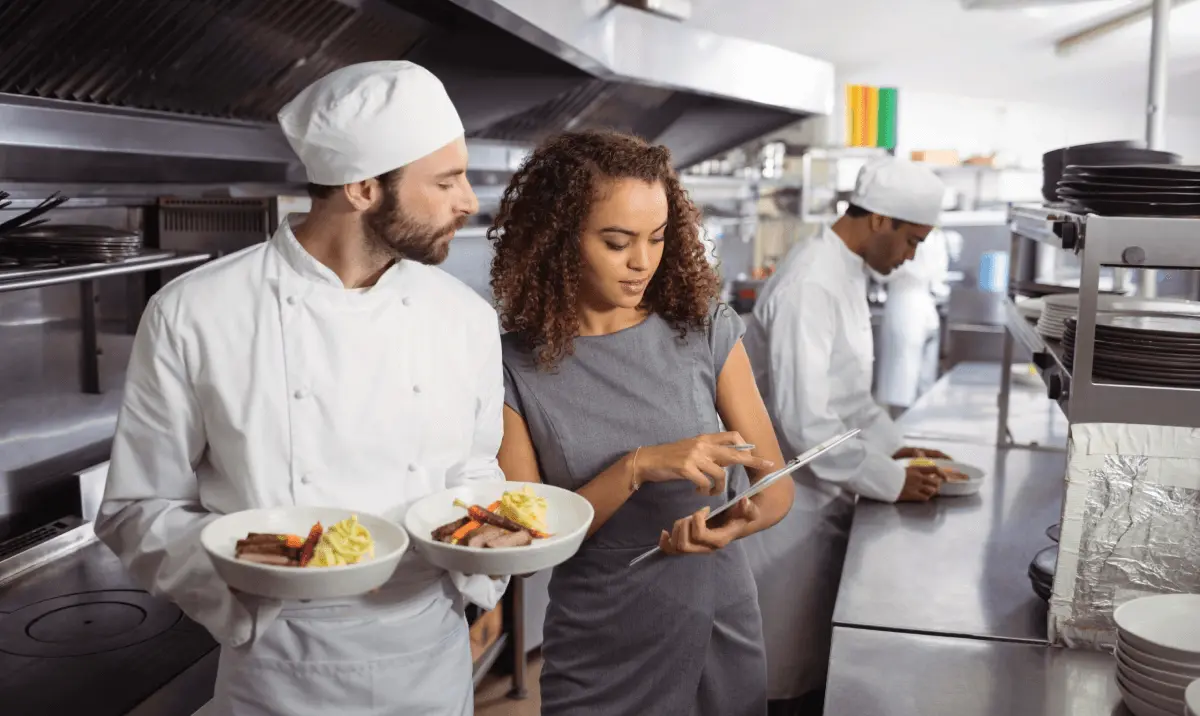

Restaurant Front of House (FoH) and Back of House (BoH) Definition
In the dynamic world of restaurant management, two primary operational areas—Front of House (FoH) and Back of House (BoH)—play a crucial role in delivering a seamless dining experience. While both areas function with distinct responsibilities, their combined efforts directly impact customer satisfaction, service quality, and overall restaurant success. Understanding the unique roles and functions of FoH and BoH is essential for owners, managers, and staff alike, as it allows for better organization, teamwork, and efficiency.
FoH encompasses all customer-facing activities, from greeting and seating guests to handling orders and creating an inviting atmosphere. It is the realm where first impressions are made and where a positive dining experience is fostered. Meanwhile, BoH is where food preparation, cooking, and behind-the-scenes operations take place, ensuring the kitchen runs smoothly and consistently produces quality dishes. Each area has specific staff roles, challenges, and demands, yet their coordination and harmony are key to a restaurant’s reputation and profitability.
In this guide, we’ll explore the definitions, responsibilities, and essential skills for both FoH and BoH teams. We’ll also look at the challenges each department faces, strategies for effective management, and how to promote collaboration for a streamlined, efficient operation. Whether you’re an established restaurateur or new to the industry, a deep understanding of these areas will equip you to create a balanced, successful restaurant.
Would you like to listen our deep-dive conversation about this article?
What is Front of House (FoH)?
In restaurant operations, Front of House (FoH) refers to all aspects of the business that involve direct interaction with customers. It’s the visible side of the restaurant where guests experience service, ambiance, and customer care. FoH staff members are responsible for creating a welcoming atmosphere, ensuring guests are comfortable, and managing the flow of service from entry to exit.
Key Functions of the Front of House
The primary functions of the FoH team focus on customer experience and operational efficiency, involving:
- Customer Service and Interaction: Greeting customers warmly, assisting with questions, and delivering a pleasant dining experience.
- Handling Reservations and Seating: Managing reservations, coordinating seating arrangements, and maintaining an organized flow of guests.
- Managing Ambiance and Cleanliness: Overseeing lighting, music, and cleanliness to create a comfortable environment for guests.
In essence, FoH operations are the face of the restaurant, where staff and ambiance directly contribute to customer satisfaction and the establishment’s reputation.
Key FoH Staff Roles and Responsibilities
Each role in the FoH has specific responsibilities that contribute to an efficient, customer-centric experience:
- Host/Hostess: Greets customers upon entry, manages reservations, and ensures smooth seating arrangements.
- Servers and Waitstaff: Takes orders, delivers food, attends to customer needs, and provides a memorable experience.
- Bartenders and Baristas: Prepares drinks and engages customers with a friendly attitude while ensuring drink quality.
- Cashiers and Customer Service Staff: Handles payment transactions and addresses any final customer inquiries or feedback.
The FoH team works cohesively to create a seamless dining experience, with each role contributing to excellent service and customer satisfaction.
Essential FoH Skills and Qualities
To provide exceptional service, FoH staff need a unique set of skills and qualities that enable them to interact effectively with guests and manage challenging situations:
- Communication and People Skills: Strong communication allows staff to convey orders accurately and build rapport with guests.
- Attention to Detail and Cleanliness: Maintaining a tidy environment and noticing details—such as when a guest’s glass needs refilling—are essential to positive impressions.
- Quick Problem-Solving and Adaptability: The ability to handle unexpected situations, from special requests to managing wait times, keeps service flowing smoothly.
These skills are vital to maintaining a welcoming, efficient, and memorable atmosphere in the restaurant, ultimately driving guest loyalty and positive reviews.
What is Back of House (BoH)?
Back of House (BoH) refers to the area behind the scenes in a restaurant, where kitchen operations, food preparation, and organizational tasks occur. Although guests rarely see BoH activities, this area is essential for producing high-quality dishes and ensuring smooth operations. The BoH team handles everything from cooking and plating to inventory management and food safety, making it the backbone of a restaurant’s operations.
Core Functions of the Back of House
The BoH team is responsible for critical functions that keep the kitchen and food preparation process running smoothly:
- Food Preparation and Cooking: Preparing ingredients, following recipes, and cooking dishes to meet quality standards.
- Inventory Management and Storage: Tracking and storing ingredients, ordering supplies, and maintaining stock levels.
- Kitchen Cleanliness and Sanitation: Ensuring the kitchen meets health and safety standards, including regular cleaning and waste disposal.
In short, the BoH staff focuses on food quality, kitchen organization, and hygiene to deliver a consistent dining experience that meets customer expectations.
Key BoH Staff Roles and Responsibilities
The BoH team includes specialized roles that contribute to efficient and safe kitchen operations:
- Chefs and Cooks: Prepare dishes according to the menu, ensuring consistency, taste, and presentation quality.
- Kitchen Porters and Dishwashers: Maintain kitchen cleanliness, handle dishwashing, and support other team members with general tasks.
- Purchasing and Inventory Managers: Oversee stock levels, place orders for supplies, and manage inventory to minimize waste and control costs.
Each role in the BoH is essential to creating a smooth operation that supports the restaurant’s quality standards, ensuring guests receive consistently well-prepared food.
Essential BoH Skills and Qualities
BoH staff require specific skills and qualities to thrive in a fast-paced, demanding kitchen environment:
- Culinary Expertise and Food Safety: Mastery of cooking techniques and a solid understanding of food safety standards ensure dish quality and compliance with health regulations.
- Organization and Efficiency: Keeping a structured and efficient workspace, with organized prep areas and storage, streamlines operations and reduces time waste.
- Ability to Work Under Pressure: BoH staff must be able to work in a high-stress environment, especially during peak times, maintaining composure to deliver consistent results.
These skills are vital for maintaining a productive, safe, and effective BoH environment that supports the restaurant’s reputation and enhances customer satisfaction.
How FoH and BoH Work Together?
While Front of House (FoH) and Back of House (BoH) have distinct roles within a restaurant, their collaboration is essential to delivering a seamless dining experience. Effective communication and synchronized efforts between these two teams ensure that customers receive their orders accurately, on time, and with the highest quality. A strong partnership between FoH and BoH also minimizes service disruptions and maximizes efficiency, leading to a more enjoyable experience for guests and a more productive environment for staff.
Communication and Collaboration Between FoH and BoH
Strong communication is the foundation of effective collaboration between FoH and BoH:
- Clear Orders and Feedback: FoH staff must communicate order specifics clearly, including special requests and dietary restrictions, to ensure BoH prepares dishes accurately.
- Real-Time Problem Solving: When issues arise—such as substitutions, wait times, or errors—both teams must work together quickly to address them, minimizing any impact on the guest experience.
Ultimately, clear communication and responsive collaboration help bridge the gap between FoH and BoH, allowing them to work as a cohesive unit for smooth, efficient service.
Tools and Technology for Better Collaboration
Using technology, restaurants can facilitate better communication and efficiency between FoH and BoH teams:
- Point of Sale (POS) Systems: Modern POS systems enable servers to input orders directly, sending them instantly to the kitchen for preparation. This reduces the risk of errors and helps BoH manage orders in the correct sequence.
- Real-Time Communication Tools: Devices like kitchen display screens and handheld tablets allow staff to update orders, communicate changes, and receive alerts, enabling faster response times and reducing miscommunication.
With these tools, both teams can stay informed and work together smoothly, even during high-traffic periods, ensuring an efficient operation that meets customer expectations.
The synchronized efforts of FoH and BoH, supported by clear communication and technology, are essential for maintaining quality, efficiency, and customer satisfaction in a restaurant. Through collaboration, these two sides of the restaurant create a unified experience that keeps guests coming back.
FoH and BoH Challenges and Solutions
Both Front of House (FoH) and Back of House (BoH) teams face unique challenges that can impact the restaurant’s overall performance if not addressed effectively. By understanding these challenges and implementing targeted solutions, restaurant managers can foster a more efficient, harmonious work environment that leads to better service, smoother operations, and higher customer satisfaction.
Common FoH Challenges and How to Overcome Them
FoH staff are at the forefront of customer interactions, which can present several challenges:
- Managing Customer Expectations and Complaints: FoH staff often deal with demanding guests, special requests, and occasional complaints.
- Solution: Train staff in effective communication, active listening, and conflict resolution skills. Empower them to handle complaints independently, with support from management when needed.
- Handling Busy Hours and Wait Times: During peak hours, managing wait times and keeping customers happy can be overwhelming.
- Solution: Implement a clear seating and reservation system, and consider offering complimentary items (like bread or drinks) during longer waits. Train staff to keep guests informed and comfortable throughout the waiting period.
By proactively addressing these issues, FoH staff can create a positive experience for guests, even in high-stress situations.
Common BoH Challenges and How to Tackle Them
BoH teams work in a high-pressure environment where efficiency, accuracy, and consistency are essential. Key challenges include:
- Maintaining Food Quality Under Pressure: High volume during rush hours can lead to errors and compromised food quality.
- Solution: Streamline kitchen operations by organizing prep stations and assigning roles for efficient workflow. Regularly review and simplify recipes to ensure consistency, even during peak times.
- Efficient Inventory Management to Avoid Wastage: Poor inventory management can result in wasted ingredients or stock shortages.
- Solution: Implement an inventory tracking system and conduct regular stock checks. Forecast inventory needs based on past data and peak periods to prevent wastage and ensure availability.
Tackling these challenges enables BoH teams to deliver consistent food quality, which is crucial for maintaining customer satisfaction.
Creating a Harmonious Work Environment for FoH and BoH
Fostering a collaborative environment between FoH and BoH teams can help overcome common challenges and improve overall service quality:
- Building Mutual Respect and Understanding: Misunderstandings can arise when teams are unaware of each other’s pressures.
- Solution: Encourage team-building activities and cross-department meetings to foster empathy and respect. Consider scheduling shifts where staff members can observe or shadow roles in the opposite department to better understand each other’s responsibilities.
- Regular Training and Role Cross-Understanding: When both teams understand each other’s duties, it promotes smoother interactions and a unified approach to customer service.
- Solution: Conduct joint training sessions on communication, order accuracy, and role expectations. Cross-train key staff members in both FoH and BoH functions to improve flexibility and collaboration.
By addressing these interpersonal challenges, restaurant managers can create a balanced, supportive environment where FoH and BoH work in harmony to achieve the restaurant’s goals.
Importance of FoH and BoH Training
Training is critical in restaurant operations, as well-prepared teams create an efficient, customer-focused environment that elevates the dining experience. Both Front of House (FoH) and Back of House (BoH) require targeted training to meet the unique demands of their roles. Through specialized training, staff members gain the skills and confidence to perform at their best, leading to smoother operations, higher guest satisfaction, and improved retention rates.
Key Training Areas for FoH Staff
FoH training should focus on customer interactions and service excellence, as this team directly impacts the guest experience:
- Customer Service Excellence: Ensuring a friendly, professional approach with every guest.
- Training Focus: Teach staff to greet guests warmly, manage seating efficiently, and handle special requests with ease.
- Communication and Handling Complaints: Addressing complaints constructively and effectively is essential to maintain customer satisfaction.
- Training Focus: Equip staff with conflict-resolution techniques, active listening skills, and strategies for calming unhappy guests.
A well-trained FoH team creates a welcoming, positive atmosphere that encourages customer loyalty and repeat business.
Essential Training Areas for BoH Staff
BoH training should emphasize efficiency, consistency, and food safety to ensure high-quality dishes and a safe working environment:
- Food Safety and Hygiene: Following strict safety protocols to maintain health standards and prevent contamination.
- Training Focus: Cover essential hygiene practices, safe food handling, and proper cleaning procedures to maintain compliance and safety.
- Recipe Consistency and Speed Techniques: Preparing dishes accurately and swiftly to meet service demands.
- Training Focus: Teach techniques for consistent plating, efficient prep methods, and time management to handle peak hours.
A BoH team with strong foundational training upholds the restaurant’s quality standards, ensuring every dish meets guest expectations.
Ongoing Training and Improvement Strategies
Continuous training and development are crucial for maintaining high performance and adapting to industry trends:
- Cross-Training FoH and BoH for Flexibility: Cross-training helps staff understand each other’s roles and builds flexibility.
- Training Focus: Allow staff members to learn key tasks in the other department, enabling better teamwork and a more adaptable workforce.
- Implementing Customer Feedback in Training: Using guest feedback to refine training programs ensures continuous improvement.
- Training Focus: Analyze customer reviews and feedback to identify improvement areas and incorporate them into ongoing training sessions.
By investing in continuous training, restaurants can create a skilled, adaptable team that works cohesively, leading to better service, higher productivity, and long-term business success.
How FoH and BoH Impact Restaurant Success?
The success of a restaurant heavily relies on the effectiveness of both the Front of House (FoH) and Back of House (BoH) teams. Each team brings unique contributions to the table, with FoH driving the customer experience and BoH ensuring food quality and consistency. Together, they influence customer satisfaction, brand reputation, and profitability. When these teams operate in harmony, the restaurant functions efficiently, delivering a memorable dining experience that keeps guests coming back.
How FoH Quality Influences Customer Retention
FoH plays a vital role in shaping first impressions and creating a welcoming environment that directly impacts customer retention:
- First Impressions and Lasting Experiences: From the moment guests walk in, FoH staff set the tone for the dining experience. Friendly greetings, attentive service, and a comfortable ambiance create positive impressions that encourage repeat visits.
- Word-of-Mouth and Online Reviews: Positive experiences often lead to word-of-mouth referrals and favorable online reviews, which attract new customers. Conversely, poor service can result in negative feedback that harms the restaurant’s reputation.
A strong FoH team is essential to building loyalty and fostering a positive brand image, both crucial elements for sustained restaurant success.
The Role of BoH in Maintaining Food Quality and Consistency
BoH is responsible for delivering the quality and consistency that make up the foundation of a restaurant’s reputation:
- Impact of Food Consistency on Brand Reputation: Consistency in taste, presentation, and portion sizes builds trust and encourages guests to return. BoH staff must adhere to recipes and quality standards to ensure every dish meets expectations.
- Managing Efficient and Hygienic Kitchen Operations: Maintaining a clean, organized, and efficient kitchen is key to producing high-quality food and ensuring health compliance, which protects the restaurant’s reputation and customer trust.
The BoH team’s commitment to quality directly affects customer satisfaction, establishing the restaurant as a reliable choice for diners.
Strategies to Maximize FoH and BoH Efficiency
Maximizing efficiency in both FoH and BoH helps create a streamlined operation that enhances customer satisfaction and optimizes costs:
- Leveraging Technology for Process Optimization: Using digital tools, such as Point of Sale (POS) systems and kitchen display screens, allows FoH and BoH to coordinate orders, reduce errors, and minimize wait times.
- Setting Clear Expectations and Accountability: Defining roles, responsibilities, and performance metrics for both teams fosters accountability and encourages consistent, high-quality performance.
By maximizing efficiency, restaurants can enhance the guest experience, reduce operational costs, and increase profitability, contributing to long-term success.
Tips for Managing FoH and BoH Effectively
Effectively managing both Front of House (FoH) and Back of House (BoH) is key to creating a cohesive, efficient, and enjoyable restaurant environment. When managed well, these teams work together seamlessly, creating a positive experience for guests and a productive atmosphere for staff. By focusing on best practices in each area and fostering unity, restaurant managers can ensure smoother operations and higher customer satisfaction.
Best Practices for FoH Management
Managing the FoH team requires attention to customer service, organization, and proactive problem-solving:
- Empowering Staff to Solve Problems: Encourage FoH staff to make quick, guest-focused decisions, such as resolving complaints, offering discounts, or suggesting alternatives.
- Tip: Give clear guidelines and train staff on common scenarios so they feel confident handling issues independently while adhering to the restaurant’s values.
- Ensuring Smooth Customer Flow and Experience: Efficiently managing reservations, walk-ins, and seating arrangements helps prevent bottlenecks and enhances the customer experience.
- Tip: Implement a digital reservation system, maintain an organized seating plan, and designate a staff member to monitor wait times during busy hours.
Using these practices, FoH managers can create a welcoming environment that leaves a lasting impression on guests and improves overall service quality.
Effective BoH Management Techniques
BoH management focuses on organization, consistency, and efficiency in food preparation and kitchen operations:
- Streamlining Kitchen Workflow and Reducing Wastage: An organized kitchen layout and clear workflow ensure that tasks are completed efficiently and reduce unnecessary waste.
- Tip: Arrange prep areas based on menu flow, create prep stations for high-demand items, and regularly review stock to adjust inventory needs.
- Scheduling for Peak Efficiency and Reducing Stress: Well-planned schedules help BoH staff manage peak times without feeling overwhelmed, ensuring food quality remains consistent.
- Tip: Schedule extra support during peak hours and provide staff breaks during quieter periods to maintain energy levels and focus.
These strategies help BoH teams maintain consistency, efficiency, and morale, which directly supports the restaurant’s reputation for quality.
Uniting FoH and BoH Teams for Success
Creating a unified team between FoH and BoH is essential for delivering a seamless experience to customers and fostering a positive work environment:
- Encouraging Communication and Feedback: Open lines of communication allow FoH and BoH teams to resolve issues quickly and share valuable feedback on operations.
- Tip: Implement pre-shift meetings to go over menu specials, customer feedback, and any operational changes, ensuring both teams are aligned.
- Hosting Team-Building Activities to Foster Unity: Joint activities help build respect and camaraderie between FoH and BoH staff, which improves teamwork.
- Tip: Organize occasional team lunches, staff outings, or friendly competitions to create a supportive, collaborative culture.
By fostering unity and mutual respect, restaurant managers can create a cohesive environment where FoH and BoH work together seamlessly, enhancing both staff satisfaction and customer experiences.
Frequently Asked Questions (FAQs) on FoH and BoH
Restaurant owners and managers often have questions about optimizing both Front of House (FoH) and Back of House (BoH) operations. Addressing these common inquiries can provide clarity on improving efficiency, fostering teamwork, and enhancing the customer experience. Below are answers to some frequently asked questions about FoH and BoH in the restaurant industry.
What’s the Ideal Ratio of FoH to BoH Staff?
Determining the right balance between FoH and BoH staff depends on your restaurant’s size, concept, and service style. For full-service restaurants, a common ratio is approximately 3:2 or 2:1, with more staff on the FoH side to handle customer interactions. Quick-service or high-turnover establishments might require a different balance based on the volume of orders and speed of service.
- Tip: Monitor customer volume and adjust staffing levels accordingly. Seasonal trends and peak hours can also influence the ideal ratio.
How Can Technology Improve FoH and BoH Efficiency?
Technology is a valuable tool for improving coordination, accuracy, and speed between FoH and BoH:
- Point of Sale (POS) Systems: Streamlines order accuracy by sending orders directly from FoH to BoH, reducing errors.
- Kitchen Display Systems (KDS): Allows BoH to track and manage orders visually, improving order prioritization and reducing wait times.
- Mobile Ordering and Tablets: FoH can take orders at the table and send them instantly to the kitchen, increasing efficiency and improving the guest experience.
Investing in these technologies helps both teams work more effectively, ensuring timely service and reducing miscommunication.
Tips for Managing FoH and BoH During Peak Hours
Peak hours can be stressful for both FoH and BoH teams, but with proper strategies, operations can remain smooth and efficient:
- FoH Tips: Encourage staff to communicate wait times to customers and keep them engaged. Use reservation management tools to avoid overbooking and allocate tables efficiently.
- BoH Tips: Prepare popular dishes or high-demand ingredients in advance to handle orders quickly. Assign specific roles to staff, such as plating or expediting, to streamline workflow during busy periods.
By planning ahead and setting clear roles, both teams can manage peak hours with less stress and higher efficiency.
How Can Cross-Training Benefit FoH and BoH Teams?
Cross-training is a powerful tool that builds flexibility, understanding, and collaboration between FoH and BoH:
- Benefits for FoH: FoH staff who understand basic kitchen processes can better communicate wait times, explain dishes, and respond to customer inquiries accurately.
- Benefits for BoH: BoH staff trained in front-end tasks gain insight into customer expectations and are better equipped to handle rushes or specific customer requests.
Cross-training leads to a more adaptable team and improves the overall service experience, helping both teams support each other during busy periods.
These frequently asked questions highlight common challenges and solutions for FoH and BoH teams. By addressing these areas, restaurant managers can create a well-rounded, efficient operation that enhances both team collaboration and customer satisfaction.
Key Takeaways
A well-coordinated approach between Front of House (FoH) and Back of House (BoH) is essential for creating a seamless dining experience and ensuring restaurant success. Here are the main points to keep in mind:
- Understanding FoH and BoH Roles: FoH staff handle customer interactions and ambiance, while BoH focuses on food preparation and kitchen efficiency. Each team plays a unique, essential role in shaping the dining experience.
- Collaboration is Key: Effective communication and shared goals between FoH and BoH ensure smooth operations, particularly during peak hours. Tools like POS systems and kitchen display screens can help bridge the gap.
- Training for Excellence: Both FoH and BoH benefit from targeted training in areas like customer service, food safety, and conflict resolution. Cross-training helps teams appreciate each other’s challenges and fosters unity.
- Managing Challenges: From handling customer complaints to maintaining kitchen hygiene, addressing common challenges in each department creates a more efficient and harmonious work environment.
- Impact on Success: The quality of FoH service impacts customer retention and reviews, while consistent BoH performance maintains food quality and brand reputation. Together, these teams contribute to a positive dining experience.
By recognizing and supporting the unique strengths of both FoH and BoH, restaurant owners can create an environment that not only meets but exceeds customer expectations.
ABOUT THE AUTHOR
Erkin Coban
Your Customers Deserve The Best
And we got Menuviel for them.
The fastest and easy-to-use online QR menu with 12+ unique features. Choose Menuviel and elevate your service quality to the next level.
Use free for the first 30 days.

In This Article

Free AI Tools for Restaurants
TRY NOW ➜

Manage what’s available - anytime, instantly
Show or hide menus, categories, or items instantly. Perfect for time-based offerings or sold-out dishes.







